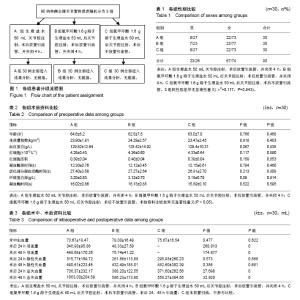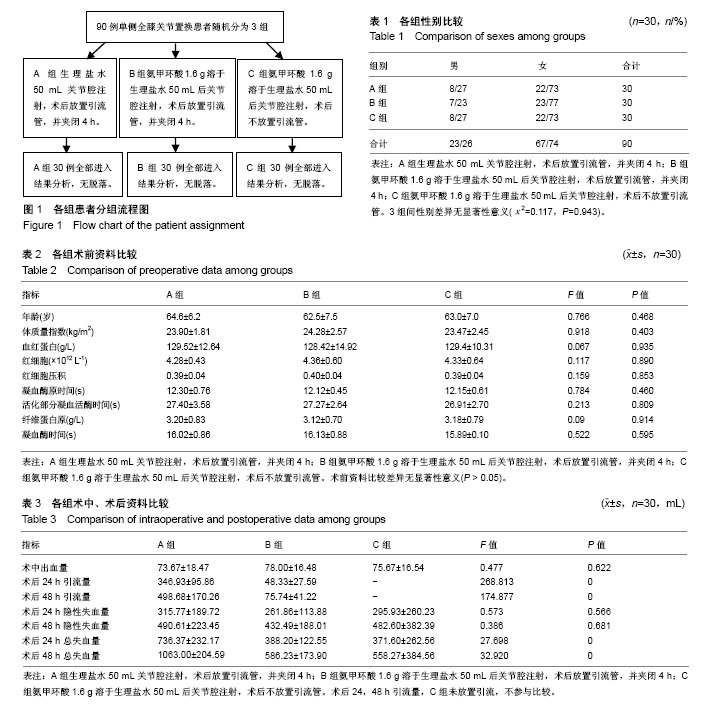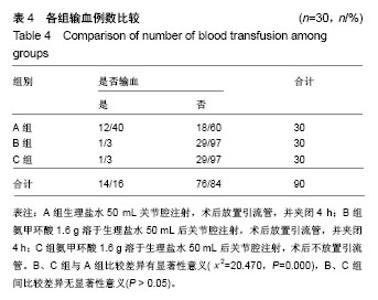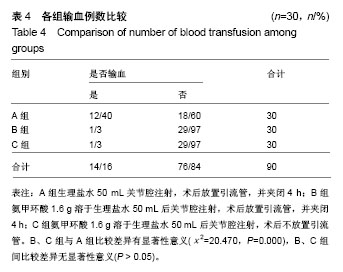| [1] 周卫,刘东海,马国涛,等.全膝关节置换过程中应用气囊止血带与高凝状态的关系[J]. 中国组织工程研究与临床康复, 2011, 15(9):1541-1544. [2] Tetro AM, Rudan JF. The effects of a pneumatic tourniquet on blood loss in total knee arthroplasty. Can J Surg.2001;(1): 33-38.[3] 韩宁,姚建华,黄炎,等.高血压对全膝关节置换术围手术期出血的影响[J]. 中国矫形外科杂志,2016,24(7):603-607. [4] Sehat KR, Evans RL, Newman JH. Hidden blood loss following hip and knee arthroplasty. Correct management of blood loss should take hidden loss into account. J Bone Joint Surg Br. 2004; 86(4): 561-565.[5] Nadler SB, Hidalgo JH, Bloch T. Prediction of blood volume in normal human adults. Surgery.1962;51(2):224-232.[6] 闵鹏,彭银虓,胡江海,等.氨甲环酸对单侧全膝关节置换失血量的影响及安全性评价[J].中国组织工程研究,2015,19(17): 2655-2660.[7] 张福江,高志国,于建华.氨甲环酸减少全膝关节置换术出血量的临床对比研究[J]. 中国修复重建外科杂志, 2007, 21(12): 1302-1304.[8] 曹万军,朱绍灵,刘显东,等.氨甲环酸用于全膝关节置换降低失血量的有效性及安全性[J]. 中国组织工程研究, 2015,19(31): 4944-4948. [9] 张瑜哲,金毅,苏礼,等.氨甲环酸减少初次单侧全膝关节置换术后失血量的临床研究[J].中国矫形外科杂志, 2013,21(8):762-765.[10] Ishida K, Tsumura N, Kitagawa A, et al. Intra-articular injection of tranexamic acid reduces not only blood loss but also knee joint swelling after total knee arthroplasty. Int Orthop. 2011;35(11): 1639-1645.[11] 王绍钱. 关节腔注射氨甲环酸对全膝关节置换术后的影响[D]. 安徽医科大学, 2014.[12] Alshryda S, Mason J, Vaqhela M, et al. Topical(intra-articular) tranexamic acid reduces blood loss and transfusion rates following total knee replacement: a randomized controlled trial(TRANX-K). J Bone Joint Surg Am. 2013;95(21): 1961-1968. [13] 董盼锋,陈跃平,康杰,等. 人工膝关节置换的引流效应[J]. 中国组织工程研究,2014,18(17):2649-2654. [14] Wang D, Xu J, Zeng WN, et al. Closed suction drainage is not associated with faster recovery after total knee arthroplasty: a prospective randomized controlled study of 80 patients. Orthop Surg. 2016; 8(2): 226-233.[15] Watanabe T, Muneta T, Yagishita K, et al. Closed suction drainage is not necessary for total knee arthroplasty: a prospective study on simultaneous bilateral surgeries of a mean follow-up of 5.5 years. J Arthroplasty. 2016; 31(3): 641-645. [16] Senthil Kumar G, Von Arx OA, Pozo JL. Rate of blood loss over 48 hours following total knee replacement. Knee. 2005; 12(4): 307-309.[17] 项群,王四清,殷俊,等. 全膝关节置换术后引流管夹闭时间选择的临床研究[J]. 河北医学,2013,19(4):537-539.[18] Shen PC, Jou IM, Lin YT, et al. Comparison between 4-hour clamping drainage and nonclamping drainage after total knee arthroplasty. J Arthroplasty. 2005;20(7): 909-913. [19] Tai TW, Jou IM, Chang CW, et al. Non-drainage is better than 4-hour clamping drainage in total knee arthroplasty. Orthopedics. 2010; 33( 3): 156-160. [20] 余存泰,覃健,侯之启,等. 全膝关节置换术隐性失血的初步研究[J]. 中国骨与关节损伤杂志,2006,21(10):784-786.[21] Bin L,Wen Y,Wu H, et al. The effect of tourniquet use on hidden blood loss in total knee arthroplasty. Int Orthop. 2009; (5): 1263-1268.[22] 宝音,张红英,段丽军,等. 氨甲环酸关节内灌注对全膝关节置换术后失血量的影响[J]. 解放军医学院学报,2016,37(6):582-585.[23] 程亮亮. 氨甲环酸静脉注射联合关节腔内灌注对全膝置换术患者的止血效果分析[J].中国民康医学,2016,28(5):16-18. [24] 魏国,梁杰,李玉鹏,等. 氨甲环酸联合肾上腺素减少单侧全膝关节置换术后出血的有效性及安全性研究[J].中国全科医学,2016, 19(3): 327-331.[25] Benoni G, Lethagen S, Fredin H. The effect of tranexamic acid on local and plasma fibrinolysis during total knee arthroplasty. Thromb Res.1997;85(3):195-206.[26] Wang H, Shen B, Zeng Y. Comparison of topical versus intravenous tranexamic acid in primary total knee arthroplasty: a meta-analysis of randomized controlled and prospective cohort trials. Knee. 2014;21(6): 987-993. [27] 董翠翠,贺付成. 局部应用和静脉注射氨甲环酸对全膝关节置换术术后出血影响的Meta分析[J].中国矫形外科杂志,2015, 23(22): 2070-2074.[28] Hegde C, Wasnik S, Kulkarni S, et al. Simultaneous bilateral computer assisted total knee arthroplasty: the effect of intravenous or intraarticular tranexamic acid. J Arthroplasty. 2013;28(10): 1888-1891.[29] 侯振扬,苏长征,庞涛,等. 初次单侧骨水泥型全膝关节置换: 氨甲环酸使用方式对失血量的影响[J]. 中国组织工程研究,2015, 19(9):1329-1334.[30] Anderson LA, Engel GM,Bruckner JD, et al. Reduced blood loss after total knee arthroplasty with local injection of bupivacaine and epinephrine. J Knee Surg. 2009;22(2): 130-136. [31] 罗志锴,郑军,胡彬. 去氨加压素在全膝关节置换术中的应用研究[J]. 中国医院用药评价与分析, 2010,10(1): 55-56.[32] Gasparini G, Papaleo P, Pola P, et al. Local infusion of norepinephrine reduces blood losses and need of transfusion in total knee arthroplasty. Int Orthop. 2006;30(4): 253-256. |



